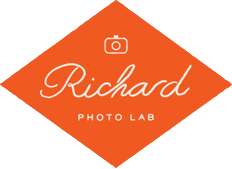How to Switch From Fuji 400H to a Different Film
The news that Fujifilm will stop producing their PRO 400H film has hit film photographers like a ton of bricks. We get it! This film is beloved in the community, and with good reason. But have hope! You CAN make incredible images on a new stock, and Richard is here to help.
We want to be honest with you about what is possible and what isn’t, what you can expect when transitioning to a new stock, and give you practical tips for getting through this not just painlessly, but with flying colors (wink).
We won’t pretend that you can carry on shooting as you always have and that the lab can magically make your photos look just like they did on Fuji 400H (as nice as that might be to hear in the moment). The truth is, you can’t “cheat” film and the lab process—folks have tried for years, and we have yet to see it happen. But you can experiment and evolve and be all the better for it.
It’s also important to remember that your film choice is just one variable of shooting—other choices you make influence the look of your final photos. Which means that there is no fully standard “Fujifilm look”, and therefore there is no uniform quick fix that everyone (or the lab) can make across the board in this situation.
Your outcomes on a new stock, whichever you decide on, are going to boil down to a mix of three things. The first is how you expose your film—it may very well be the number one influencer of a final film image. The second is how the lab handles your film, because the same negative can be scanned many different ways. Lastly is “the view”, and by that we mean… your view as a photographer (don’t be hypercritical, even though it can be really hard not to be), and your client/intended audience's view (will they notice all the minute things you do, will it change how they experience your work?).
This is about getting the BEST results, not the SAME results. Period.
So, let's get into it...
SHOULD I START TESTING NEW FILM?
Yes. Good grain, y’all—YES! Do NOT underestimate this step. Is it extra work for you? Sure. Does it mean taking off your artist hat and putting on your scientist hat? Yup. Is the knowledge you will get from testing an important investment in getting the long-term results you want? ABSOLUTELY!
When you master exposure on a new film stock and find the sweet spot for your look/style, you give the lab a better negative. Starting with better ends with better, plain and simple.
Yes, there is enough Fuji 400H left in the world that you won’t be forced to switch immediately. But getting a head start trying out new stocks now means that you can seamlessly transition to shooting a new film fulltime once your stash runs dry.
You’ll want to grab your light meter and do some bracketed test rolls. Learn how here.
Speaking of testing, we’re doing our own in-depth testing now on different ways to shoot and process other stocks to see what steps will help get Kodak stocks looking closer to Fujifilm. We’ll share everything we’ve learned with you as soon as we can!

The above images are from some testing we did on pushing & pulling film. Our goal was not at all to make Portra 400 look like Fuji 400h. Both images were scanned on Noritsu for a neutral color balance and neutral density (lightness/darkness). But check out how similar they can look without even trying! Certainly differences are perceptible side-by-side, but imagine what we could do by adressing exposure & scanning adjustments and keeping an open mind.
Our friend Sandra Coan spent a year testing Kodak films—see some of her results here.
SHOULD I TEST A NEW FILM ALONGSIDE MY FUJI 400H?
That’s a personal choice, but here’s our view...
Seeing the same shot side-by-side on different stocks can be a great way to compare the inherent qualities of a film stock. And you should definitely do that with the other stocks you're testing. But knowing that soon you will not have access to Fuji 400H can make testing it alongside new stocks torturous.
It’s kind of like that TV show “Say Yes to the Dress” when the salesperson tells the bride not to try on a frock that’s over their budget—every other dress will never seem as good in comparison, even though the other dresses are the only ones the bride can get.
Instead of approaching this testing as a comparison, think of it as the opportunity to choose and master your new materials.
If you do choose to compare the films apples to apples, then you’ve got to be willing to accept this: your results will be an illustration of the fact that, while you can get different stocks to look similar, they will not be exactly the same—and there is no magical way to make it so.
WHAT FILM SHOULD I SWITCH TO?
While this answer will be different for everyone, Portra 400 and Portra 800 are certainly the strongest contenders.
You may ask yourself “Why wouldn’t I just switch to another Fuji stock instead of switching to Kodak?” Well, Fuji doesn’t make any other professional-grade films, only consumer-grade films. And that is an important distinction. Professional-grade film stocks are manufactured very precisely and consistently so that results are rendered super similarly between batches and emulsions. That consistency then carries over to your photographs.
Also, if you’re a medium format shooter, Fujifilm does not make any other stocks in 120—so you will also lose some of the characteristics of shooting medium format that you love.
Portra 400 (and every Kodak film) has a warmer base than Fuji 400H. But there are also a number of foundational similarities that make it a good choice: the speed, the beautiful skin tones, the fine grain, the natural color saturation.
Portra 800 is actually a stock that many Fuji shooters already turn to once the light gets low and they need a higher speed film. It complements Fuji 400H quite well. But it doesn’t need to be reserved for only low light. One of the reasons this film visually melds so well with Fuji 400H (which has a more neutral cool base) is that it tends to render less red tones than Portra 400.
That being said, these are not your only options—you may find that Portra 160 is your new jam! That’s why you’ve got to test for yourself.
If you take one hard-and-fast piece of advice from this blog (besides the importance of testing), let it be this: DON’T OVEREXPOSE YOUR KODAK FILM!!! This isn’t just our advice, but the instructions from Kodak—you know, the guys that have been testing and producing this film for decades. You simply cannot expose Kodak film the way you do Fujifilm. Overexposing increases saturation, and in Kodak films it will make the red tones in the base more prominent—the exact thing that makes it different from Fuji 400H.
WHAT SCANNER SHOULD I USE WITH MY NEW STOCK?
We'd suggest that you try Noritsu. As a newer piece of technology, it gives the lab better control over the final appearance of your scans. That flexibility can come in handy as you're figuring out exactly what you can do with a new stock.
That's not to say that Frontier couldn't work. And if you tested the two scanners with your Fuji 400H and found you preferred the Frontier, the idea of switching might sound a little "iffy". Have some rolls scanned on both scanners so you can compare the results and see what you like best! Just contact us when you place your order, and be sure to tell us the reason why you are testing both scanners.
SHOULD I TELL THE LAB I’M SWITCHING WHEN I SEND MY FILM?
You can… and communication throughout the process of switching films is key to your success. But there are definitely more important things that you can tell us than “I used to shoot Fuji 400H and now I’m shooting XYZ”. Communicating your scan preferences precisely (especially as they relate to skin tones, because that is where we apply them first and foremost) is probably the most valuable thing you can do when sending in your new stock choices. We use those preferences as a target for your scans, and the target itself doesn’t really change because you’re using a new stock—it just changes one of the materials we’re aiming with.
The best time to talk about the fact that you’ve made a switch is AFTER you’ve gotten some scans back on a new stock. In fact, it is VITAL! More on that next…
HOW LONG WILL IT TAKE TO GET MY “LOOK” ON A NEW FILM?
Well, that all depends. Certainly doing bracketed testing with other stocks will give you a leg up—that foundational testing will help you focus in on tweaking the details with the lab.
We have a guideline at Richard called the “3 jobs rule”—we usually use it in the context of switching to a new lab, but it also applies to this scenario. Give it at least three jobs to start really loving your scans (if it's sooner, then hooray!).
During that three-job window, there’s one key thing you must consider and communicate to the lab: what didn’t you like? When you can really pinpoint what visual elements you don’t like, we can work together to figure out the cause. Was it your exposure? The lighting? The scanning technician’s eye? From there, we can work together to find solutions that will get you closer to the look you want.
WHAT IF I BUILT MY COLOR PROFILE USING FUJI 400H?
We have gone through the "film switch" with many photographers who built their color profile when they were shooting Fuji 400H. Our focus is always first and foremost on the appearance of skin tones, and we have been able to successfully match preferred styles with a little work and a lot of communication. Through the process, the number one wrench in the works has always been photographers exposing Kodak film like Fujifilm (aka, overexposing it). You CAN learn to expose your new stock in a different way to get results you love.
If you have a color profile with Richard that was created using Fuji 400H, contact us at info@richardphotolab.com! We can make the necessary tweaks together when you are switching to a new stock.
Want more info? Watch our IGTV with Sandra Coan, where we talk about her successful film stock switcheroo, what she learned during her extensive testing, and why she finally decided a Kodak stock was her perfect match.

